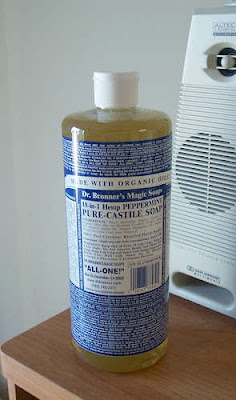 Photo courtesy of Pixel Drip's photostream
Photo courtesy of Pixel Drip's photostreamSince I can no longer use commercial shampoos and laundry soaps without a skin rash or worse, I have been researching to see what's IN them that affects me. First, most things advertised as soaps are actually detergents.
The difference? Petroleum. Detergents are made from petroleum products, and they contain a high percentage of surfactants, foaming agents and alcohols. Then they add cheap synthetic fragrances to mask the chemical smell. Because these formulations (in liquid form) could spoil, they add preservatives and anti-bacterial agents.
A commonly used preservative is paraben, which has been detected in breast cancer tumors. That doesn't necessarily mean parabens caused the cancer, but the mere presence worries me. Parabens are also found in toothpaste, food additives, cosmetics, shaving gel, personal lubricants and moisturizers.
The chemicals in detergents easily penetrate the surface of the skin and accumulate in our tissues. Although this may not affect most people initially, it causes allergic reactions in a lot of us. And the toxins are accumulative.
 Photo courtesy of mwri's photostream
Photo courtesy of mwri's photostreamSoaps, true soaps, are made from natural products like fat and lye. Your great-grandmother probably made her own soap, or traded with a neighbor who did. Lye was easily made by dripping water through fireplace ashes, and fats from the butchered hogs and beef was always available. Making soap is actually pretty easy, needs far less energy than commercial soaps, and there's no residue for the landfill.
I urge you to check the ingredients even in hand-made soaps because not all of them have all natural ingredients, especially if there is significant production. They may use animal fats from CAFO's which often contain residues of pesticides and antibiotics, and synthetic fragrances. My digestive system no longer tolerates soybean, canola, sunflower and safflower oils, and if I can't even digest them, WHY would I want to absorb them through my skin?
Castile soaps are made mostly with oilve oils and other natural oils; hand-crafted recipes usually add palm and coconut oils to harden them and create more lather. Since I eat (and tolerate) those oils, they make a safe soap for me.
Besides the goat-milk facial soaps, I also use Dr Bronner's soaps (pure-castile soaps) for laundry, bathing, shampoos, and washing my truck. Soaps DO create a scum, but it is 100% biodegradeable. I can live with that. The fragrances used in Dr. Bronner's soaps are organic essential herbal oils, and are less than 2/10 of 1% by weight anyway. Supposedly you can use Dr Bronner's peppermint soap for toothpaste, just a drop or two... but I'm too chicken to try it.
I used to buy Tom's of Maine's natural toothpaste, succumbing to advertising... but finally having read the ingredients (fluoride, sodium lauryl sulfate, aluminum tubes, xylitol, highly refined vegetable glycerine, salicylates, sorbitol, etc.), I stopped. Actually I stopped long before I recently decided if things require an ingredient label, I generally won't buy them, and if it is something claiming to be a food, I won't buy it at all.
My grandfather mixed just fine salt (slightly abrasive) and baking soda (sweetens and deodorizes) and water to brush his teeth, and that works just fine for me. My changes in diet will reduce if not eliminate tooth decay by changing the bacteria in my mouth (and system), so brushing is more for cosmetics and a feel-good mouth.

No comments:
Post a Comment
I'd love to hear what you think about my posts! We all learn together.